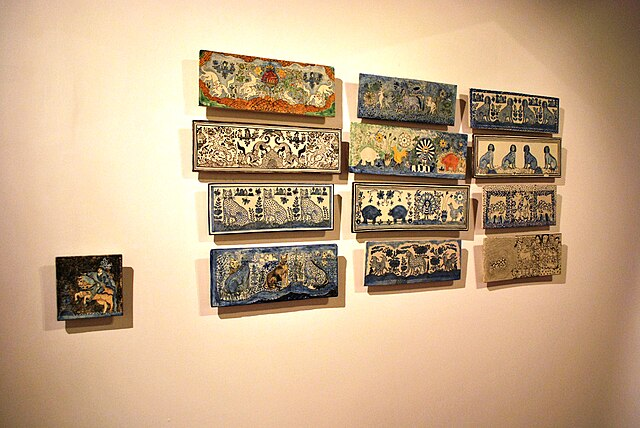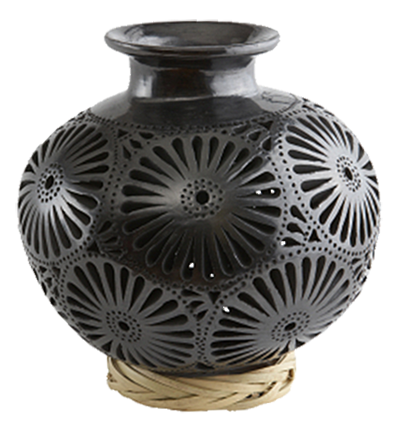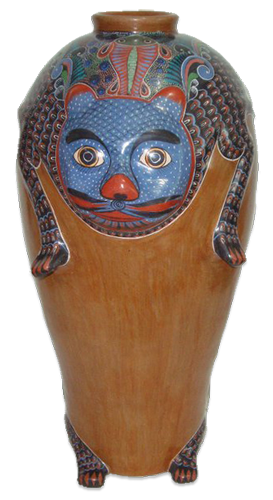Among all expressions of Mexican folk art, pottery holds a special place.
It is the most abundant, diverse, and enduring form of arte popular mexicano, a union of earth, water, fire, and imagination that has evolved through thousands of years of history.
From ancient vessels shaped by hand to modern works admired around the world, Mexican pottery mirrors the country’s cultural diversity, geography, and spiritual heritage.
Each region has its own clay, its own colors, and its own stories, yet all share a single creative pulse: transforming the most humble material into something extraordinary.
Pre-Hispanic Pottery
The origins of pottery in Mesoamerica stretch back more than 4,500 years, to the time when early communities settled permanently and began shaping their world through art.
The earliest pieces found are gourd-shaped vessels, likely used to carry and store water.

Pre-Hispanic ceramics were made by hand-coiling techniques and fired in open pits or low-temperature kilns.
They were often burnished or slipped, sometimes painted with natural mineral pigments.
Over time, each civilization developed its own distinctive style, from the elegant Maya polychrome bowls to the finely carved Zapotec urns and Teotihuacan figurines.
Clay served domestic, ceremonial, and funerary purposes. It was both a tool and a sacred medium, reflecting the Mesoamerican view that earth itself was alive.
Many of these techniques and motifs survived the arrival of the Spanish and remain visible in today’s regional pottery traditions.
Pottery During Colonial Times
With the Spanish colonization came profound changes in technology and aesthetics.
The Spaniards introduced the potter’s wheel, the enclosed kiln, and lead-based glazes derived from metal oxides.
They also brought new forms, such as tiles, olive jars, candleholders, and roof tiles.

Because New Spain was part of the Manila–Acapulco trade route, exotic goods from China and the Philippines arrived regularly.
Chinese porcelain in particular left a lasting impression on Mexican artisans.
In response, potters in Puebla began experimenting with tin-glazed earthenware, adapting European and Asian techniques into something entirely new — Mayolica pottery, which evolved into the celebrated Talavera de Puebla tradition.
This cultural exchange created a unique fusion: Indigenous forms, Spanish technologies, Arabic influences, and Asian motifs, all blended into a distinctly Mexican identity.
Contemporary Mexican Pottery
Modern Mexican pottery reflects this layered heritage.
It carries traces of ancient symbolism, colonial craftsmanship, and global influence, all reinterpreted through the hands of local artisans.

While industrial ceramics have replaced handmade wares for daily use, folk potters have turned toward decorative and artistic production to preserve their traditions.
Today, Mexico’s pottery landscape is a mosaic of regional styles, each defined by its clay, firing methods, and community legacy.
Below are some of the most iconic and enduring pottery traditions in Mexico:
Oaxacan Black Clay (Barro Negro)
In San Bartolo Coyotepec, Oaxaca, clay has been shaped since pre-Hispanic times.
The region’s dark, metallic-looking pottery gained worldwide fame thanks to Doña Rosa Real de Nieto, who in the mid-20th century discovered a polishing technique that gave the clay its distinctive shiny black finish.
Before that discovery, the pottery was matte gray and mostly utilitarian. Today, it is prized for its elegance and luster, used in both traditional and contemporary forms.

Example: Openwork black clay vase from Oaxaca.
Multicolored Clay from Izúcar de Matamoros (Barro Policromado)
This Puebla town is known for its vibrant, hand-painted pottery.
Artisans decorate incense burners, candleholders, and sculptures with bright pigments and floral motifs.
The style gained international recognition through Alfonso Castillo Orta, whose creativity elevated Izúcar’s pottery to fine art.

Example: Multicolored Tree of Life Candle Holder
Among the town’s most iconic works are Trees of Life, candelabras, and intricate religious or cultural scenes.
Painted Clay from Guerrero (Barro Pintado)
In the Mezcala region of Guerrero, artisans merge pottery and folk painting.
The pieces feature vivid depictions of birds, flowers, markets, and daily life, inspired by Nahua storytelling traditions.
Each design captures the rhythm of community life through color and movement.

Example: Painted clay fish depicting a village scene.
Clay Figurines from Tlaquepaque, Jalisco
Near Guadalajara, the town of Tlaquepaque has been a center of clay work for centuries.
In the early 1900s, Pantaleón Panduro transformed its pottery tradition with his remarkable sculptural talent.
He became famous for lifelike clay busts and figurines, which earned him international acclaim and established a local school of portrait ceramics that continues today.

Example: Pantaleon Panduro at his workshop in 1883.
His descendants and apprentices preserved this legacy through nativity scenes, religious figures, and effigies that merge technical skill with emotional expression.
Pottery from Capula, Michoacán
The small town of Capula is known for its delicate tableware, flower motifs, and dotted patterns.
Its artisans have developed a unique decorative style featuring hand-painted dots and stylized fish and flowers.
In recent years, Capula gained fame for its clay Catrina sculptures, combining elegance, tradition, and regional identity.

Example: Capula tea set with traditional floral design.
Majolica Ceramics
Majolica pottery was introduced to Mexico in the 16th century and became deeply rooted in cities such as Puebla, Guanajuato, and Aguascalientes.
The style is characterized by white tin glazes decorated with cobalt blues and warm earth tones.
Today, renowned workshops such as Gorky González, Capelo, and Cerámica Santa Rosa continue this centuries-old art, blending tradition with contemporary design.

Example: Majolica piece by Gorky González.
Talavera from Puebla
Talavera de Puebla remains the crown jewel of Mexican ceramics.
It is a legally protected name reserved for pottery made within Puebla using authentic 16th-century techniques.
Traditional workshops like Talavera Uriarte preserve colonial-era patterns, while Talavera de la Reyna introduces modern interpretations.
Both uphold the artistry that makes Talavera one of Mexico’s most recognizable folk arts.

Example: Talavera Uriarte building, Puebla.
Mata Ortiz Pottery, Chihuahua
Near the ancient ruins of Paquimé, the town of Mata Ortiz has revived the ceramic excellence of its ancestors.
Inspired by the prehistoric Casas Grandes pottery, artisans like Juan Quezada and Adrián Rojas hand-coil elegant vases with geometric and natural motifs.

Their work has achieved international acclaim for its precision and sophistication, blending ancient methods with modern artistry.
Clay Figures from Metepec, Estado de México
Metepec has crafted pottery since pre-Colonial times, once specializing in sun-faced plaques and green-glazed tableware.
In the 1940s, Modesta Fernández Mata created a new kind of sculpture: the Tree of Life, which became an emblem of Mexican folk art.

Today, her descendants, the Soteno family, continue this tradition with award-winning pieces celebrated around the world.
Tonalá’s Burnished Clay (Barro Bruñido)
In Tonalá, Jalisco, potters create pieces that gleam like stone, polished entirely by hand.
This burnished clay is decorated with graceful animals, floral designs, and soft, natural colors like pinks, blues, greens, and creams.

Artists such as José Luis Cortéz Hernández continue to refine this style, achieving surfaces so smooth they seem glazed without ever touching enamel.
A Living Heritage
Across Mexico, pottery continues to evolve while honoring its roots.
It embodies the soul of the land, the textures of clay, the strength of fire, and the creativity of those who shape it.
From the glossy black vases of Oaxaca to the painted vessels of Guerrero and the monumental Trees of Life from Metepec, each piece connects the past with the present.
Mexican pottery is more than craft; it is a dialogue between ancient earth and human imagination.
It carries within it the hands of generations, the memory of civilizations, and the enduring artistry of a people who never stopped creating beauty from the soil beneath their feet.

Leave a Reply